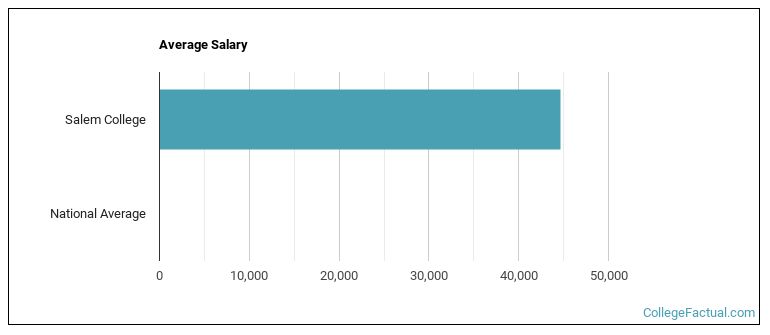 by our College Data Analytics Team
by our College Data Analytics TeamExplore the best ranked schools for the programs you are most interested in.
Salem was not ranked in College Factual's 2025 Best Overall Colleges report. This could be for a number of reasons, including lack of data.
The acceptance rate at Salem College is 87%, which is higher than many other schools to which you may be applying. But don't think getting into Salem is a sure thing. The admissions staff is still going to review your application to see if you are a good fit for the school.
With a student to faculty ratio of 16 to 1, Salem College is about average in this regard as the nationwide rate is 15 to 1. While this does not translate directly to class size, it's a good indicator of how much time professors will have to spend with their students on a one-on-one basis.
Another measure that is often used to estimate how much access students will have to their professors is how many faculty members are full-time. The idea here is that part-time faculty tend to spend less time on campus, so they may not be as available to students as full-timers.
The full-time faculty percentage at Salem College is 49%. This is comparable to the national average of 47%.
The freshmen retention rate of 73% tells us that most first-year, full-time students like Salem College enough to come back for another year. This is a fair bit higher than the national average of 68%. That's certainly something to check off in the good column about the school.
The on-time graduation rate for someone pursuing a bachelor's degree is typically four years. This rate at Salem for first-time, full-time students is 64%, which is better than the national average of 33.3%.
Find out more about the retention and graduation rates at Salem College.
During the 2017-2018 academic year, there were 492 undergraduates at Salem with 378 being full-time and 114 being part-time.
| $0-30 K | $30K-48K | $48-75 | $75-110K | $110K + |
|---|---|---|---|---|
| $14,974 | $14,669 | $12,914 | $18,812 | $32,380 |
The net price is calculated by adding tuition, room, board and other costs and subtracting financial aid.Note that the net price is typically less than the published for a school. For more information on the sticker price of Salem, see our tuition and fees and room and board pages.
It's not uncommon for college students to take out loans to pay for school. In fact, almost 66% of students nationwide depend at least partially on loans. At Salem, approximately 53% of students took out student loans averaging $5,150 a year. That adds up to $20,600 over four years for those students.

Get more details about the location of Salem College.

Contact details for Salem are given below.
| Contact Details | |
|---|---|
| Address: | 601 S Church St, Winston-Salem, NC 27101 |
| Phone: | 336-721-2600 |
| Website: | www.salem.edu/ |
| Most Popular Majors | Bachelor’s Degrees | Average Salary of Graduates |
|---|---|---|
| Student Counseling | 24 | NA |
| Business Administration & Management | 14 | $43,299 |
| General Biology | 13 | NA |
| Music | 13 | NA |
| Biochemistry, Biophysics & Molecular Biology | 10 | NA |
| History | 9 | NA |
| Teacher Education Grade Specific | 7 | NA |
| General Psychology | 7 | NA |
| Communication & Media Studies | 6 | NA |
| General Education | 6 | $36,646 |
Online learning is becoming popular at even the oldest colleges and universities in the United States. Not only are online classes great for returning adults with busy schedules, they are also frequented by a growing number of traditional students.
In 2022-2023, 199 students took at least one online class at Salem College. This is a decrease from the 338 students who took online classes the previous year.
| Year | Took at Least One Online Class | Took All Classes Online |
|---|---|---|
| 2022-2023 | 199 | 67 |
| 2021-2022 | 338 | 69 |
| 2020-2021 | 636 | 636 |
| 2018-2019 | 97 | 66 |
If you’re considering Salem College, here are some more schools you may be interested in knowing more about.
Curious on how these schools stack up against Salem? Pit them head to head with College Combat, our free interactive tool that lets you compare college on the features that matter most to you!
Footnotes
*The racial-ethnic minorities count is calculated by taking the total number of students and subtracting white students, international students, and students whose race/ethnicity was unknown. This number is then divided by the total number of students at the school to obtain the racial-ethnic minorities percentage.
References
More about our data sources and methodologies.